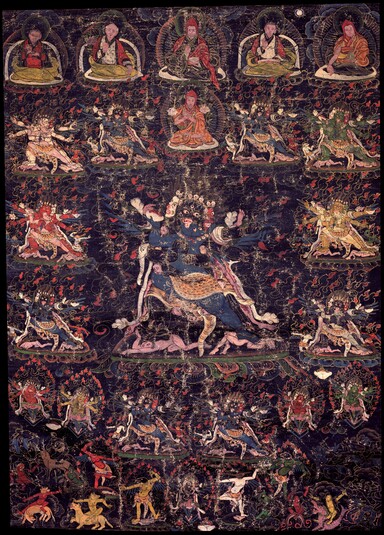
Item: Vajrakila (Eight Pronouncements)
| Origin Location | Tibet |
|---|---|
| Date Range | 1700 - 1799 |
| Lineages | Sakya |
| Size | 54.61x39.37cm (21.50x15.50in) |
| Material | Ground Mineral Pigment, Black Background on Cotton |
| Collection | The Brooklyn Museum of Art |
| Catalogue # | acc. #BMA 71.195, Gift of Mrs. Jacob M. Kaplan |
Classification: Deity
Vajrakila, Heruka (Tibetan: dor je pur ba, trag tung. English: Vajra Peg, Blood Drinker). The Activity Deity from the set of Eight Herukas (Tib.: ka gye) of the Mahayoga Tantras of the Nyingmapa School according to the Ancient Khon Tradition of Sakya.
Sanskrit: Vajrakila
Fearsome and wrathful, blue in colour with three faces, six hands and four legs, the right face is white and left red, each has three eyes, a gaping mouth and yellow hair flowing upward. The first pair of hands hold a kila (three sided peg) at the heart. The right hands hold a five and nine pointed vajra and the left hands hold a trident and a mass of flame. Unfurled behind are two large wings decorated with vajras. Adorned with a crown of five skulls, earrings, bracelets and a necklace of fifty heads, he wears an elephant hide across the back and a tiger skin as a lower garment. The consort Diptachakra (Flaming Wheel) is black in colour with one face and two hands holding a skullcup in the left and a gold wheel upraised in the right. Adorned with jewels, gold and a garland of fifty dry skulls she wears a leopard skin skirt and the left leg raised to embrace the male consort. Atop the splayed bodies of Maheshvara and Uma, a sun disc and multi-coloured lotus the terrific deities stand surrounded by the orange-red flames of pristine awareness.
At the top center is the Indian teacher Padmasambhava wearing a red pandita hat. Directly below is Sakya Pandita Kunga Gyaltsen. At the upper left are Sachen Kunga Nyingpo and Dragpa Gyaltsen. At the right side are Sonam Tsemo and Chogyal Pagpa.
Surrounding the central figure are the retinue and attendant deities of the mandala.
"...the king of wrath, bhagavan Vajrakumara, with a body blue-black [in colour], three faces and six hands. The right face is white, left red, the center blue. Held with the two pairs of right and left hands are a nine and five pointed vajra, a blazing mass of fire and a trident. The remaining two roll a kila. The body is huge and heavy, with bared fangs, three eyes - round and red, brown hair flowing upward; wearing an elephant hide, human skin, and a tiger skin as a lower garment. Adorned with white, red, green, and black snakes as a crown, necklace and sash, decorating the arms and legs. Five dry skulls adorn the head. Wearing a garland of fifty fresh [heads], marked with clots of rakta, spots of great ash and a smear of grease, adorned with various jewel ornaments. With four legs the right are bent and left extended atop the head of Ishvara - face down, and the breast of Uma, standing in the middle of a massive fire of pristine awareness." (Sakya Ngawang Kunga Lodro, 1729-1783).
Khon Lineage: Dharmakaya Samantabhadra, Sambhogakaya Vajrasattva, Nirmanakaya Padmasambhava, Khon Lu'i Wang Srungwa, Khon Dorje Rinchen, Khon Sherab Yontan, Khon Tsultrim Gyalpo, Khon Dorje Tsugtor, Khon Gekyab, Khon Gethong, Khon Balpo, Khon Shakya Lodro, Khon Rog Sherab Tsultrim, Khon Konchog Gyalpo, Tsechen Kunga Nyingpo, Lobpon Sonam Tsemo, Jetsun Trakpa Gyaltsen, Sapan Kunga Gyaltsen, Chogyal Pagpa Lodro Gyaltsen, etc.
Jeff Watt 3-2002
Tradition: Sakya Deity Paintings
Tradition: Nyingma Deity Paintings
Buddhist Deity: Vajrakila Main Page
Collection of Brooklyn Museum of Art
Buddhist Deity: Vajrakila (Khon Tradition)
Collection of Brooklyn Museum of Art (Deities)
